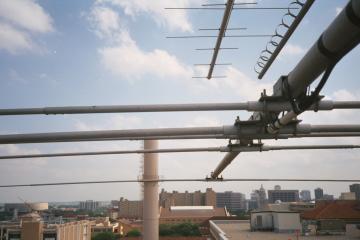
N5XU participated in the ARRL September VHF QSO Party conducted from 1800 UTC 9 September to 0300 UTC 11 September 2000. We operated in the limited multioperator class, with W5JLP, KB5LBN, and WM5R operating. We were active on 50 MHz, 144 MHz, 222 MHz, 432 MHz, and 1296 MHz.

|
This contest was an experiment. Having heard rumors that there was a certain amount of discontent in the major Texas cities (particularly the Dallas area) about VHF contesters calling CQ a lot on 144.200, we decided to try the contest by calling CQ off the call frequency almost exclusively. The hypothesis that one could still make a decent score this way was disproved.
On Saturday afternoon, we had two zero hours. During this time, our operators were calling CQ consistently on 144.205 MHz and 50.135 MHz, trying every direction to get some station to respond. Almost every station N5XU worked this weekend on 144 MHz was either called by us on 144.200 or moved to two meters from another band. Very few stations found us on 144.205. Notable exceptions were K5TR, W5MB, and AJ4F, all worked on CW. On Sunday, of course, there were four full zero hours with a single QSO made over a five hour period. This isn't terribly unusual for the September VHF QSO Parties of recent years in South Texas. The zero hours on Saturday are unusual.
Just how much worse was our score this year? The worst since 1996, the first year that N5XU operated the contest. In 1996, the club station had just 10 watts on six meters, used an HT for 440 MHz FM, and had no other gear at all for 222, 432, or 1296 MHz. In 1996, N5XU made 69 QSOs on 50 and 144 MHz combined. This year, we made only 59 QSOs on those two bands! Compared to last year, our score was down over 70%! Compared to 1998, our score is down 83%!
Clearly, not calling CQ on the two meter call frequency is a sure method to kill a VHF contest effort in South Texas. There are a lot of stations out there that will never call CQ, and will not listen anywhere other than 144.200 MHz. Unless you call CQ to get their attention and get them to call you, they will not make it into your log. Being unable to raise QSOs on two meters greatly affects the QSO totals and multipliers on other bands as well, as many of the higher band QSOs are made by moving a station found on two meters to the other bands. This has always been the theory, but prevailing wisdom needs to be inspected once in a while. Maybe stations would tune around and find us after all? The unfortunate conclusion is pretty clear - to be successful, you must call CQ and make QSOs on 144.200 MHz.
It was fun to work so many members of the Central Texas DX & Contest Club (CTDXCC) on the VHF/UHF bands. This was the best showing ever on VHF/UHF for CTDXCC members, with at least K5NA, K5PI, AC5AA, AB5K, N5KO, K5TR, N5XD, W5TD, and N5IW making it into N5XU's logs. In fact, even though the two clubs' membership totals are almost equal, there were more stations on from the ranks of the CTDXCC than from the Roadrunners Microwave Group (RMG)!
| Frequency | QSOs | Points | Grids |
|---|---|---|---|
| 50 MHz | 19 | 19 | 8 |
| 144 MHz | 40 | 40 | 10 |
| 222 MHz | 10 | 18 | 7 |
| 432 MHz | 22 | 42 | 7 |
| 1296 MHz* | 4 | 12 | 3 |
| Total | 91 | 119 | 32 |
* Submitted as check log only, not included in totals
| Claimed score | 3,808 |
|---|
Contest Logging was done with TR LOG contest logging software. The following reports and log were created using TR LOG's post-contest processor.
|
Last Updated 26 June 2020 wm5r@wm5r.org |